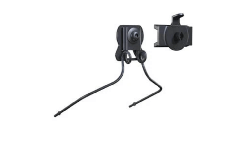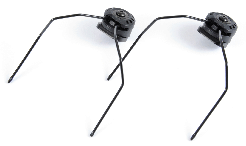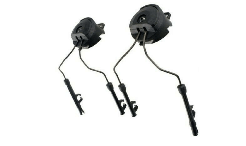TACTICAL HEADSET BUYER'S GUIDE

Tried & True
Best Bang For Your Buck

Ease of Purchase
Best Bang For Your Buck
Best Bang For Your Buck

Budget Headset
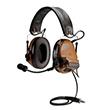
3M PELTOR COMTAC LINE
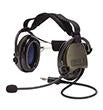
MSA SORDIN LINE
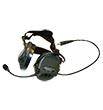
SAFARILAND LIBERATOR LINE
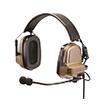
OTTO NOIZEBARRIER TAC
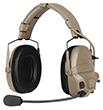
GENTEX OPS-CORE AMP

OPSMEN M32 ELECTRONIC COMMUNICATIONS
PROS
Most people with a military background are going to have immediate familiarity with these. On top of this, we also have the gel inserts in the earmuff section of the headset, which provides comfort to the user over extended periods of time. If you’re looking to make a large purchase order for a department or unit, 3M also offers great deals on bulk orders for government organizations and are incredibly familiar with the purchase process. Did we mention you can generally find these for around $400?
When it comes to the Supreme MIL CC, we’ve got a very slim profile design that allows the headsets to used comfortably with a wider variety of ballistic helmets. This includes use with the ACH, LWH, and even the older PASGT style of helmet. It also has a back strap, and hook and loop style top strap to keep the headset firmly in place without the use of rail adapting systems.
The Liberator’s have very close similarities to the Sordin line up. Though we cannot confirm if they are re-branded Sordins or not. Either way they have a unique and interesting feature that some of our other headsets simply lack. Digital Situational Awareness Enhancement, otherwise known as DSAE, provides 360 degrees ambient sound reproduction that gives the user a much more specific direction towards the sound that is being amplified than other headsets.
The largest win here for the end-user is that they are getting a fully operational headset that has everything they need straight out of the box. At around $800 total, this item will come straight out of the box with everything you need to get it mounted on your lid and straight into operations. There’s no need to purchase extra accessories with the Otto NoizeBarrier TAC. It’s ready to go on mission straight away.
The amp is far and away one of the most comfortable headsets on the market today. With all the extras that are available for them, they’re also one of the most innovative and capable sets that were truly designed with helmet mounting in mind. Once you have a set of these, it’s immediately clear that they were designed specifically for use with a ballistic helmet in absolutely every sense.
We’ll shoot you straight here, you’re going to make sacrifices entering at this price point. That said, the biggest pro is you are entering at this price point with a fully functioning headset that really punches above it’s weight. Is it the coolest looking? No. Is it the most comfortable, Not really. Does it get you communicating with your team without breaking the bank? Yes.
CONS
The primary power source for these headsets are AAA batteries. As a result, you have to minimize and maximize your time with the headsets turned on. Changing these batteries out in 3M brand headsets also takes some practice to do it efficiently in a field environment and causes wear to the device over time.
Somewhat hard to purchase. The best way to find a set of these is through sites like e-bay, where you can find them used ranging from $600 to $1,500 USD. With that said, you can find the lower echelon versions on Amazon for around $300 to $400 easily.
The price-point. While easier to get your hands on than Sordin’s top-end military issue headsets, the Liberator line has no lower level options for the end-user. That means you can expect to pay between $700 and $1,400 for this headset.
The biggest con to this headset is the lack of military or law enforcement service. It’s not a deal breaker, and the headset will work efficiently for you, but they do lack the service record of some of the other headsets on this list.
All those extras we just mentioned? They’re sold separately. That’s the largest drawback to this headset. If and when you choose to go this route, make sure you put everything you need, and some of things you might not need, in your shopping cart with them. Otherwise you’ll find yourself making a second purchase later down the road.
The largest con to this headset overall appears to be some minor issues in quality control, with some users complaining that overall, they simply fit way too tight. It’s also worth noting that with the QC issues mentioned above, you may want to double up on your hearing protection your first few times out to the range just to be sure. That said, at the price point, and since Opsmen has a great return policy, we’d suggest giving these a go if you’re in dire need with low cash flow.
OUR RATING
Due to the lower price point of the ComTac III from Peltor, and our familiarity with the platform, we still highly recommend picking up a set of these. We know they won’t disappoint or fail to accomplish the mission.
These are a solid choice in headset, if you can get your hands on them. We highly recommend this set to anyone with the capability of finding them, as they are an absolute must have for individuals with lower cut helmets. Even the lower price-point Sordins are an incredible value.
If you can find a set of these on sale, or are prepared to pay the price-tag, these are almost a must have item in our opinion. If they’re good enough for our nation’s top communicators, then they’re perfect for your mission too.
All around, this is a solid headset that we cannot recommend enough. They are produced by Otto, which is a great company with a solid reputation and the products are all produced here in the United States. They won’t cost you an arm and a leg, and you can land yourself a comfortable headset that will attach directly to your helmet with no fuss.
With the base price of this headset being $945, you’re getting exactly what you pay for. On top of this, you’re also getting one of the most comfortable and capable communications headsets that exists on the market currently. Just make sure you buy everything you need the first go-around, and you’ll enjoy this purchase for a long time.
At the sub $100 price point, you really can’t complain about these. Generally speaking, at this price point you’re not getting any communication capabilities whatsoever, but with the M32 you’re getting a whole lot of bang for your buck. We rate these as the best budget option in the entire tactical communications space. If you’re not looking to spend $350 + this is where you need to be.
KEY FEATURES AND SPECS
PTT – Dual Channel Capable
NRR – 20 dB
IP Rating – IP67
Amplification – Environmental Listening
Our Comfort Rating: 5/5 Stars with Gel Cup Inserts
PTT – Dual Channel Capable Depending on Model
NRR – 19/27 dB
IP Rating – IP67
Amplification - Environmental Listening
Our Comfort Rating – 4/5 With Gel Cup Inserts
PTT – 250 Different Radio Interfaces and Manufacturers. Dual Channel Capable.
NRR – 21/29 dB
IP Rating – IP67
Amplification – Revision (REV6) Digital Sound Processing
Our Comfort Rating – 4/5 With or Without Gel Inserts
PTT – Dual Channel Capable
NRR – 23 dB
IP Rating – IP68
Amplification – 3D Soundscape with Advanced Situational Awareness Technology
Our Comfort Rating – 5/5 Heavily Depends on Helmet Cut.
PTT – Dual Comms Capable
NRR – 22dB
IP Rating – IPX7
Amplification – 3D Hear-Through Technology
Our Comfort Rating – 5/5 Without Double Hearing Protection Option
PTT – Single Channel Communications
NRR – 22dB
IP Rating – IPX5
Amplification – Basic Sound Amplification
Our Comfort Rating – 4/5
The Ultimate Communications Headset Buyer’s Guide
So, you’re in the market for a communications headset, but don’t have the slightest idea of where to start? Perhaps a fast helmet type headset or one for a MICH helmet that provides under helmet hearing protection. Don’t worry, we’ve got you covered. We’ve laid out some of our top picks for tactical headsets in this article and given you the pros and cons of each along with the price-points.
On top of this, we’re also going to give you some insight into what types of comms equipment you should consider running, and how you should consider running that in conjunction with your kit to see the best results.
We can’t claim to make you an expert on this topic with a singular article. We can however share some of our experience and expertise with you to make you an educated buyer. Educated buyers make better decisions with their money, and this is certainly a space where you could burn a ton of money by mistake. Also you won't find affiliate links to headsets here, just our thoughts to help you out!
Let’s get into it.
How We Decided
Each headset tested was purchased or borrowed, we never accept anything from product manufactures.

8
Models Tested

5
Experts Interviewed

1000+
Consumer Reviews
WHO NEEDS A COMMUNICATIONS HEADSET?
This is where we need to start. If you’re entering this space, you need to be prepared to spend upwards of, at the very least, $500 to get yourself quality gear. So, the first question we want you to ask yourself is this. “Do I need a communications headset, or just hearing protection?”
Maybe you’re in the preparedness community and you’re looking to up your small group’s capabilities. Maybe you’re very heavily and seriously invested into the Airsoft community, or group sports shooting and you want to elevate your game to the next level. If either of these apply to you, then chances are you might actually need a communications headset.
But what kind of radio am I going to run if I’m not using issued gear you ask? Don’t worry, we will cover this in another review!
COMMUNICATION AND FEATURE CONSIDERATIONS PRE-PURCHASE.
Before we start making recommendations for headsets, let’s get you educated first. There’s a little bit that goes into making this leap into the tactical communications gear space, and we want you want to enter it armed to the teeth and ready to buy.
OPSMEN M32 HEADSET
The Opsmen M32 is your entry level headset. It has many of the same functions as higher priced options but at a much lower cost. We suggest this headset for the enthusiast, but not for actual duty work. They are a relatively newcomer to headsets though and we wouldn't be surprised if their quality and offerings improve as time goes on.
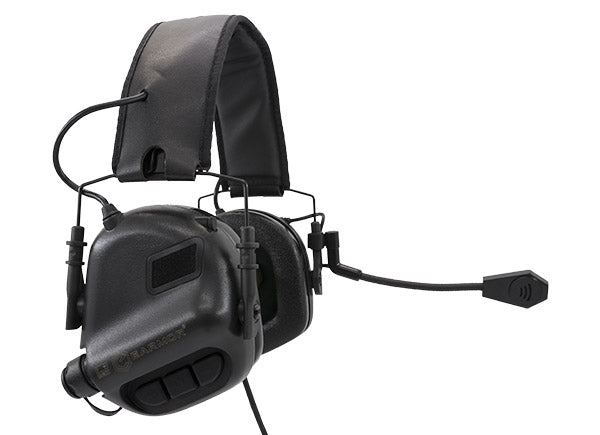
NOISE REDUCTION RATING (NRR)
A noise reduction rating is given to each device, generally from a 3rd party laboratory. Similar to ballistics tests done on armor plates and helmets, this is something you absolutely want to know before you purchase anything.
This is how the math works. You take the base NRR of the item, and first subtract the number seven. So, if our NRR is 33 – 7 we are left with 25. We then divide that number by two and round up. So, NRR = 33-7/2 = 13. The final number is then subtracted from the decibel number of the noise source for our actual reduction in noise.
If a company does not publish their NRR, you need to steer clear. Your ears will thank you later.
INGRESS PROTECTION RATING (IP)
IP ratings stands for “Ingress Protection”. Each device intended for operational use will have some sort of functioning IP rating published within the specs of the device. This is usually found somewhere near the NRR.
IP obviously stands for Ingress Protection Rating, but the numbers granted both mean separate things. So, if you have a device rating with IP68, the 6 will be the rating against particle protection, and the 7 will stand for water protection.
If there is no number provided for particle protection, there will simply be an X put in its place. That means, anything with an IPX rating will only tell you that items rating for water proofing.
3M PELTOR COMTAC LINE
The Peltor ComTac III is the gold standard in communications headsets, and for good reason. It is one of the most versatile and proven headsets on our list and has served the special operations community at large throughout the Global War on Terror. It is also only the third generation of this brand of headsets. If you have more money to spend, you can’t go wrong by upgrading to the ComTac IV or V which both boast some impressive improvements. They also offer their dual comm setups for you JTACs and radio guys running more then one radio! Peltor headset accessories exist for just about any application as well.
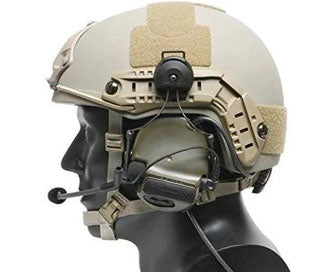
WHAT OPTIONS ARE CURRENTLY AVAILABLE?
Hold onto your butt. Things can get muddy here, as options in this space are incredibly plentiful and the list is growing every day. The options in the list are not the end-all be-all for tactical communications headsets in this space. In fact, we could spend a small fortune and still not even scratch the surface as far as getting our hands on every single item.
With that in mind, rest assured that these headsets have been curated from the top items currently available. We have chosen these products based on their current use in both the Military and Law Enforcement communities, as well as their attainability for the average person. To include a budget tactical headset. We’ve also laid out our pros and cons for each to help you better make a decision based on what we have laid out.
If you choose to venture outside of this space, use the other parts of the article to help you make a better-informed decision for purchase. Check out the video we did with COMM Gear supply for additional info!
GENTEX OPS-CORE AMP
The Ops-Core amp was specifically designed to be used in conjunction with the GenTex line of helmets. As a result, these will both seamlessly and effortlessly attach to any GenTex brand lid to provide you with an excellent communications solution. If you want to mount them to say our ATE helmet, that uses M-LOK style rails. Hit up https://www.unitytactical.com/ for the adapter!
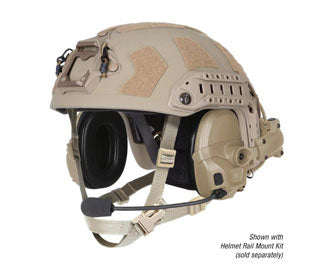
HELMET MOUNTING VS UNDER-HELMET WEAR
This is a question that’s going to come down to personal preference for you as an individual. There are both pros and cons to mounting your new tactical communication gear to your helmet, or simply wearing it underneath. Our recommendation is to mount the comm gear to your helmet using one of the many available mounting options that currently exist and purchase a second set of non-communications ear protection headsets for those times where you are shooting without the need for comms. Most of the companies listed here offer both options!
This will give you more versatility in your ability to train both with and without your helmet. If you’re undecided though, here’s some thing to consider for either option. In the end, only you can make this decision, and remember, with all things gear set-up things are subject to change after you try it in the field.
MOUNTED PROS AND CONS
Once your headset is mounted, it’s not going to be an easy process to un-mount the system while you’re in the field. That’s your biggest con. Once the headset is mounted, in order for you to use the communications system you’ll either need to disconnect fully and move to a handset, or simply wear your helmet at all times where you need to use the communications gear.
The pros here are quite simple, and in my opinion worth it. Comfort during operations is key, and having your headset mounted to your helmet is a huge tick in the box of comfort. Also, with most systems you are able to fold the system up onto the helmet to allow your ears the ability to breath, without the worry that you’re going to full Private Pyle and lose the system.
Speed is also another factor. Once mounted, your communications gear is only as far away from you as your helmet. There’s no need to adjust and re-adjust your headset underneath your helmet, nor is there a possibility of you having to move a long distance with communications gear causing you discomfort. To mount headsets to a helmet there are a couple of options. Our RAK system will work with both M-LOK and ARC type rails on a helmet!
OTTO NOIZEBARRIER TAC
The Otto NoizeBarrier Tac Headset uses advanced situational awareness technology to deliver a near perfect reproduction of the user’s surroundings. This is accomplished through the use of small microphones on the outside of the headset that create an amazing 3-D soundscape. We also really liked the low-profile earcup design that does not interfere with shouldering a firearm!
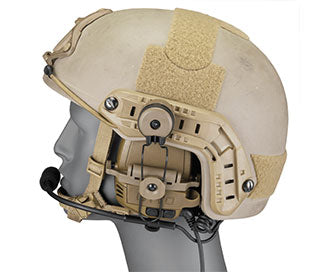
DID YOU KNOW?
Most of the headsets listed in this article have an optional feature upgrade for gel ear cups. Getting this upgrade is a massive boost to the comfort level of any headset, as the gel forms better to your head, and applies less pressure than the standard issue earcups. If you haven’t worn a headset with gel earcups, you really don’t know what you’re missing!
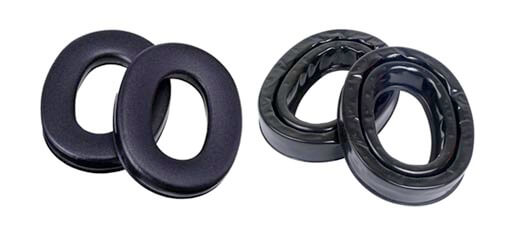
SAFARILAND LIBERATOR LINE
The Liberator line of headsets is heavily used in the law enforcement communities, especially for SWAT and SRT Units who are almost always plugged into communications equipment. As a result of their long wear time, the Liberator is a very comfortable headset on our list regardless of which generation you manage to get your hands on.
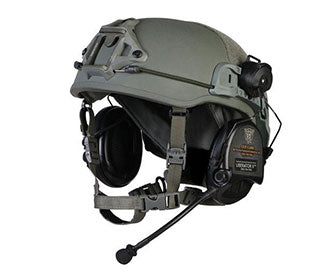
BALLISTIC HELMET FEATURE CONSIDERATIONS
The largest con here is the fact that you’re going to need to adjust and readjust a head strap underneath of your helmet. Also, you won’t be able to fold the earmuffs away from your ear to get much needed airflow to your head without removing your helmet. Once your headset is on, and your helmet is situated, that’s the way you’re going to be for a while.
With that though, there’s also a few pros to using your headset this way. First, you’re fully capable of just popping your top without losing comms. Also, since your headset isn’t mounted to your helmet, you’re free to train with the communications gear as hearing protection if your selected headset has noise cancellation as a feature.
At the end of the day though, how you choose to wear this equipment is up to you. Remember, you can always make changes based on your training. So, train often with this equipment once you have it so you can find the set-up that works best for you as an individual shooter.
BALLISTIC HELMET FEATURE CONSIDERATIONS
When it comes to accessories and add-ons, you really need to do your research. Some communications headsets come with everything you need to go on mission straight out of the box, others come out of the box only ready to protect your hearing on the range. This includes the right connection to your PTT (push to talk), but also the right connections to your radio of choice!
Do your due diligence here. You absolutely need to ensure that everything you need to start using this equipment is going to come on that first order. Failing to do so could cost you valuable time, additional money in shipping costs, or outright make the purchase irrelevant if the gear is not compatible the communications equipment you intend to use.
MSA SORDIN LINE
The MSA Sordin line is another battle-tested and proven line of headsets. Engineered in Sweden, the Sordin line is an absolute steal in value, as retired but still functioning headsets can easily be found through military surplus sites and stores nation-wide. It’s also worth noting that there are many variations of this line of headsets available, many that come directly with gel earcup inserts for maximum comfort.
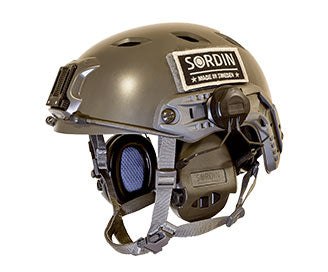
That was quite a bit of information thrown at you all at once. Feel free to bookmark this page, or just leave the tab open while you do your searching. We know that making a purchase in this vertical is a big financial commitment, so do your research!
If you have any questions, please feel free to message us on either Instagram or Facebook, and we’d be more than happy to lend you a hand or give you our opinion on a piece of gear that you are currently looking at. If you have anything you would like to see us add to this article, the above two locations are also a great place to message us, or just email us directly!
We love to hear from our readers, and our customers. Together, we can help educate each other on these systems in order for us all to be better educated consumers in this space.

